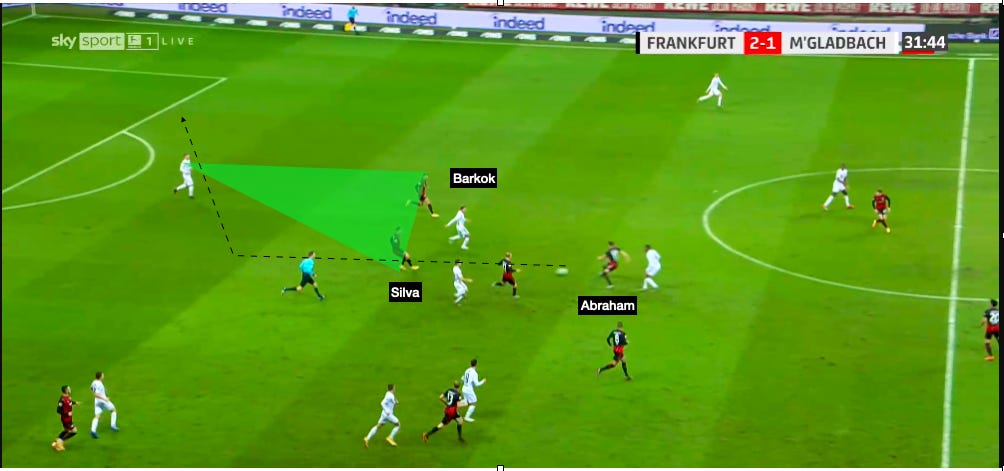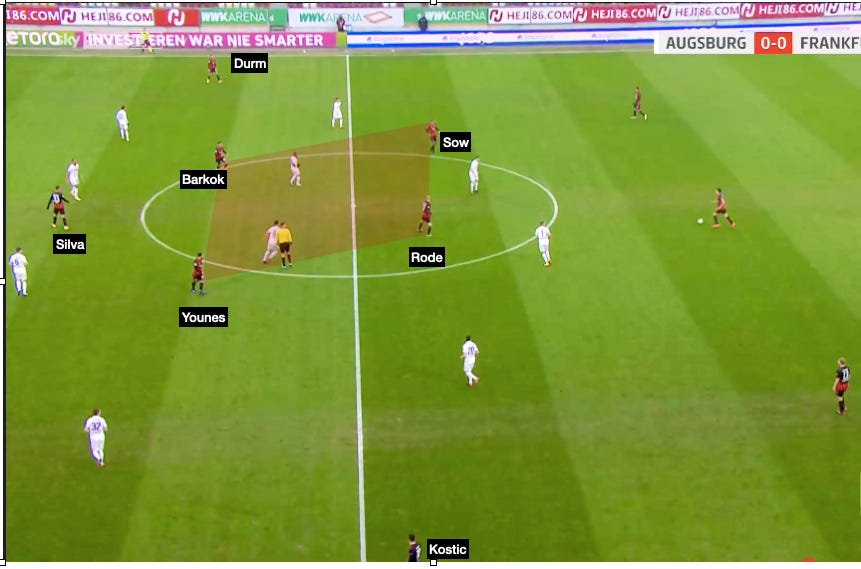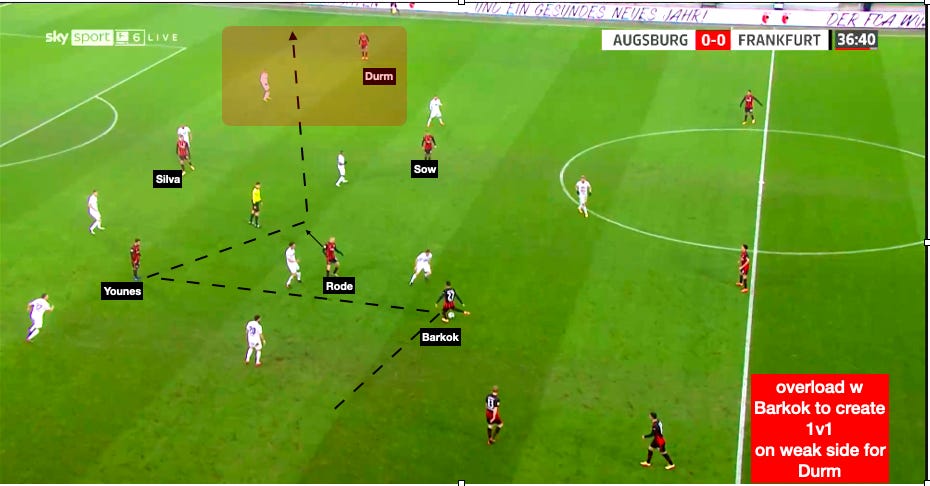Frankfurt Amin Love: How Younes and the switch to the double 10 changed Eintracht's season
plus defensive and midfield adjustments, overcoming adversity, analysis Kostic of, Kamada, Jovic, Silva and more
This two-part analysis will try to showcase these important aspects that resulted in Eintracht Frankfurt currently being the most in form team in German football.
The previous post, which ended with the introduction of the 3-3 draw vs Gladbach highlighted the problem with the result. However, in terms of the performance and especially as the first match with the 3421 featuring Amin Younes as the main actor, it serves as the beginning of the Eintracht turnaround. In this piece I will try to show the benefits of the new system for the Frankfurt attack, which in terms of numbers is a 9-0-1 record, a goal difference of +18, an xG difference of +12.25 (Understat) or 8.2 (Fbref)
In terms of personnel, this analysis will start the examination of the offensive improvement from Younes’ effects in particular on Filip Kostic, while acknowledging the constant presence and evolution of Andre Silva from a striker who had half a season of good production (top 20-60 in most metrics, into a top 10 striker in the big 5 leagues (goals, goals per 90, xG/90 per Fbref.com)
In addition, it will also highlight the previous defensive issues that stabilized by switching to a younger, more dynamic back 3 and how Frankfurt found more solutions with the ball as a result.
Finally, it will take a look at the potential future of this squad and what the “price” of success could be for Frankfurt’s players and coaches as they battle for the Champions League.
But in order to get to all of that, we first need to examine that crazy 3-3 draw vs Gladbach in detail:
I. All great streaks start with adversity
Gladbach started out promisingly, attacking the space ahead of the back 3 via the deep movements of Thuram and Stindl in transition, stretching the back line via high fullbacks, particularly with Stefan Lainer getting beyond Kostic and pulling Hinteregger out. This left some space for Thuram/Plea/Stindl and the arriving CMs - Kramer and Bénes to combine centrally. The lead up to Stindl’s free kick goal was one such example, with Hinteregger losing possession vs a double team and Rode/Sow not securing the center, so that Bénes had a free run and would be fouled by Hasebe.
At the same time, Frankfurt pressed very aggressively and high against Gladbach’s buildup. The risk was as we saw above, the press being broken and Gladbach running riot in transition, but the reward was also high: with Younes or Sow winning the ball in central positions they would just need the final through ball to create a chance.
In addition, by inviting Gladbach to press with Sow joining the back line and pushing the side CBs wide, they could go over the top to Kostic, who ran down the wing and earned a corner from which Lainer’s handball ensued.
Right after the equalizer, Frankfurt began to take advantage of their positional/dynamical advantages offered by Barkok (often joining the wings, but also excellent in transition) and Younes between the lines, pulling out the LCB Elvedi. This instance in the 23rd minute was intercepted by Ginter making a great play,
but Andre Silva’s next off-ball run off the shoulder of the German international CB was rewarded. Barkok’s chip over the top was as brilliant as Silva’s composed finish.
Already in the 27th minute, captain David Abraham, who by then has announced his decision to return to Argentina, looked out of position on a cross that Marcus Thuram just missed. In my understanding it took considerable good will on his part to not leave after this match, staying until MD 16 with Schalke as his farewell game. The veteran would pick up his first yellow, muscling Stindl to the ground in the 31st minute - Plea drew Hasebe out, Hinteregger was dragged wide by Hannes Wolf - but then made up for it just seconds later.
Frankfurt superior, but blow it late
He read the vertical pass intended for Plea and quickly played the ball to Andre Silva, who ran a 2v1 vs Elvedi with Barkok, who added a couple humiliating dribbles before making it 3-1.
Eintracht dominated at this point: Hinteregger’s wide positions and sidestepping of the press allowed Kostic to run in, while Rode’s interceptions launched transition attacks that Gladbach’s midfield duo of Kramer and Bénes struggled to deal with. In the second half, although Marco Rose brought on Denis Zakaria and Valentino Lazaro to add some pace and dribbling to his midfield, it was Frankfurt that had 2 medium-sized chances, with Silva and Younes failing to make the most of two efforts inside the box from about 9-12 yards out. It seemed like this was Eintracht’s match to win, but the 80th minute second yellow on Abraham (cynical tactical foul on Embolo in transition) came back to bite them. Aymen Barkok’s 89th minute would be clearance caught Embolo’s leg and it was just a silly/forgiveable mistake that still had SGE 3-2 up. I’m not sure the excuse was (for Dominik Kohr) to leave Stindl open on this 95th minute cross,
but Stindl outjumping\wanting the ball more against the recovering Ilsanker/Hasebe and the trio of Frankfurt players standing around is inexcusable.
Interestingly, and this is something Hütter has taken a lot of flak for over the years from SGE fans, the coach elected to praise the spirit and performance of his team - aside from the first ten and the last 5 minutes. Hütter pointed out that although they had been winless for the ninth match in a row, he was pleased with the unity and mentality of the team and that they would be rewarded for it.
II. Hütter was right, the change is happening! Advantages and disadvantages of the 3421
That analysis is actually supported by what I saw and hopefully showed in the previous segment. And well, that’s why he is in charge, as Adi Hütter was exactly right about results catching up with performance, with Frankfurt amassing 25 points - 6 more than second place Leipzig - over the next 9 outings, with over 20 expected points to boot.
Chance creation, possession and chaos vs Augsburg
In general, the Augsburg match was a lot more chaotic and while that is not usually a bad thing for the Hütter team, they were fortunate to have skated by. It was a strange match where Eintracht both created and conceded several big chances, but neither Silva (0 for 3 on shots on target), nor Younes (2 efforts on target, well-saved by Gikiewicz) nor Kostic’s headers and Erik Durm’s excellent long-range effort resulted in a goal.
They faded all of the Augsburg big chances, with Niederlechner missing in transition (Tuta, Hinteregger), Caligiuri not finding Finnbogason accurately enough in the box in the 15th and the Icelander missing a huge chance in the 27th and in the 45th, while Marco Richter and Michael Gregoritsch also wasted opportunities.
Their fortunes seemed to have turned with an own goal where Younes had no shot at getting to the ball and a really nice run and finish by Ilsanker into the box in the 87th minute, sandwiched by 3 shots before and after by FCA.
Although they were fortunate, their shape and setup also had some excellent offensive ideas that were responsible for creating chances.
In terms of tactical concepts, their 3421 with the double ten of Barkok and Younes used a midfield box, that was difficult for Augsburg, because the 10s occupied spaces ahead of the CBs (who had to deal with Andre Silva) and behind the Khedira-Gruezo double pivot, who weren’t always sure if they should follow Barkok-Younes or press Sow - Rode.
Frankfurt’s positional edge did also leave something on the table, as Rode didn’t manage to go for the most progressive option here (he later apologized to Durm).
The other benefit of the double ten formation - Dortmund and Leipzig do this well - is to create overloads on one side by shifting one of these creative playmakers. Here’s an example after a quick throw-in where the right-sided 10 Barkok dribbles inwards all the way from the left side. Note how FCA’s 442 is taken apart by the Barkok/Younes/Rode combination which ends with Durm nearly scoring.
Last but not least, - the 3421 base shape with high wingbacks Durm and Kostic pinning the fullbacks wide also had advantages in transition moments:
whether by winning the ball back and immediately stretching the last line,
or in counterpressing, following a long ball that Augsburg clear. Notice how Younes\Barkok have a dynamic and positional advantage to get to the second ball ahead of the Augsburg DMs.
All in all, this match can be seen as the turning point: a little luck in front of goal, but the attacking movements were starting to click with Barkok/Younes and Kostic. Still, despite the 2-0 win and the clean sheet, the 2.0 non penalty xG allowed was in 3rd place for worst defensive metric (Union had 2.1 and Bayern in the 5-0 had 3.4) of the season. Frankfurt would go on to rectify this situation in the next few matches.
III. Tightened defense as Hinteregger replaces Hasebe, Ndicka returns, Tuta steps up, Younes starts to make a big difference.
One issue they had was personnel and experience based and affected their 3 CB backline. Although Makoto Hasebe was one of the best CBs in the first half of the previous season and is set to continue playing for potentially one more year at age 37, his best role might be more of a DM at this point. Although, he used to play at RB and as the right sided 8 in the diamond at Wolfsburg under Felix Magath, and mostly as a CB (with occasional stints at DM) since he moved to Frankfurt, he began his career as a central midfielder in Guido Buchwald’s 3-5-2 in the J-League.
While he has a tremendous understanding/reading ability of the game, his timing this season has often looked out of sync with the others when he was in the last line.
As we will see later on, in the bigger matches, his intelligent timing in pressing can be an asset higher up the pitch.
In addition, his passing and ball retention/progression skills are perhaps better utilized at DM, though he has 99th percentile shot creating actions (via his dribbles/carries into the final third as we discussed in part 2), vs 18th as a midfielder. Also, Djibril Sow reestablished his spot as the more box to box DM: he offers less dropping into the backline for ball circulation (though he has the incisive pass in him, see the Schalke match) more dynamism and defensive volume. In the other spot, Hütter has essentially opted for Hasebe over Sebastian Rode, whose performances have dipped slightly (missed 4 games with nagging injuries), but as we see there isn’t a whole lot between the two players when it comes to data comparison. In fact, Rode comes out looking better in some creative stats and pressing, though Hasebe has the edge with 41% of dribblers tackled vs 30% and he’s way ahead on clearances.
Of course, this could just have to do with Hasebe regaining the captain’s armband after Abraham’s departure, but the much larger factor is the rejiggering of the back 3.
As we saw, the starting back 3 in the early parts of the season was the 37-year-old Hasebe in the center, 28-year-old Hinteregger at LCB and 34-year-old Abraham at RCB. In fairness, the ideal starting back 3 would’ve sure included Even Ndicka - another scouting gem by Ben Manga for 5.5m from Auxerre at 18 - who has been close to a fixture for the last 2.5 seasons, but picked up a ligament injury after the DFB Pokal match vs 1860 Munich in mid September. He can also play as an out and out LB due to his speed and dynamism (see last season’s switch to a 4 chain), and with him in the lineup, Frankfurt have lost just once from 13 matches (vs. Wolfsburg).
As you can see from all the green in the scouting report, the tape and his age profile, he’s easily the Eintracht CB with the most potential.
With Ndicka at LCB, Hinteregger moves to the center, and as we saw Hasebe is pushed up to DM, but of course in Frankfurt’s system those players are responsible for buildup and ball circulation.
That leaves us the right side, where long-time captain David Abraham’s retirement has been looming for a while now. 2 years ago Fredi Bobic and Ben Manga smartly signed Tuta - for 1.8 million from Sao Paulo’s reservers - and as they did with others like Kamada sent him on loan to Belgium where he played from November to March as a regular at RCB in a 4231 at Kortrijk. Despite the odd positional error here and there (see vs Augsburg or Lewandowski’s third goal in the 5-0) he has looked very capable in defending and has superb athleticism to recover when he’s asked to join the attack.
So much for the theoretical improvements. In the final part, this analysis will cover the defensive upgrades as one of the driving forces behind the current unbeaten run by analyzing some upsets and winnable games. Furthermore, we will break down the offensive success and the agents behind it. I’ll also speculate on the future of Eintracht’s squad, wondering whether this success is sustainable, or an example of another outlier season like 2018\19, or perhaps a new reality which represents a mixture of the two….



















